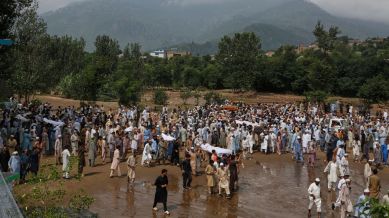Stay updated with the latest - Click here to follow us on Instagram
The provincial government has designated the hardest-hit mountainous districts — Buner, Bajaur, Swat, Shangla, Mansehra and Battagram — as disaster zones.

Sudden floods triggered by torrential rains have killed more than 300 people across Pakistan, authorities said Saturday, as entire villages in the mountainous north-west were devastated.
The National Disaster Management Authority (NDMA) reported at least 321 deaths in the last 48 hours, with 307 of them in Khyber Pakhtunkhwa province. Nine fatalities were recorded in Pakistan-administered Kashmir and five in Gilgit-Baltistan.
Weeks of relentless monsoon rains, massive landslides and raging floodwaters have torn through the region since early June, sweeping away entire neighbourhoods and leaving homes in ruins.
Rescue workers said more than ten villages were reduced to rubble in Buner district of the Khyber Pakhtunkhwa province. Many residents remain missing as washed-out roads and landslides blocked access.
More than 30 homes in the village were swept away. The district situated north of Pakistan's capital Islamabad, was the worst-hit, with 184 confirmed killed so far, Reuters reported.
“Over 120 bodies have been recovered from this area alone so far. Just a few days ago, there was a vibrant, living community here. Now, there’s nothing but heaps of large rocks and debris,” Bilal Faizi, spokesperson for Rescue 122, told CNN.
In Salarzai, a subdivision of Bajaur District in Khyber Pakhtunkhwa Province, one of the worst-hit areas, locals described the flooding as apocalyptic.
“When the rain intensified, it wasn’t long before I felt as if an earthquake had struck — the whole ground was shaking,” said Farhad Ali, a student, CNN reported.
“In the pouring rain, my entire family ran outside, and we saw a torrent of mud and massive boulders rushing through the stream near our house. It felt like doomsday had arrived, with scenes straight out of the end of the world.”
AFP reported villagers gathered for funeral prayers in a paddock, weeping over bodies covered in blankets as excavators dug through mud-soaked hills.
Around 2,000 rescue workers have been deployed across nine districts of Khyber Pakhtunkhwa Province, but officials say relief operations remain extremely difficult.
“Heavy rainfall, landslides in several areas and washed-out roads are causing significant challenges in delivering aid, particularly in transporting heavy machinery and ambulances,” Bilal Ahmed Faizi, spokesperson for Khyber Pakhtunkhwa’s rescue agency, told AFP.
“Due to road closures in most areas, rescue workers are travelling on foot to conduct operations in remote regions. They are trying to evacuate survivors, but very few people are relocating due to the deaths of their relatives or loved ones being trapped in the debris.”
Separately, five crew members died in Khyber Pakhtunkhwa when a helicopter crashed during relief efforts, a provincial official confirmed.
Pakistan's Prime Minister Shehbaz Sharif chaired an emergency meeting in Islamabad on Friday to review rescue operations after what officials described as one of the deadliest cloudbursts in recent years.
Deputy Prime Minister and Foreign Minister Ishaq Dar said civilian and military teams were leading rescue and relief efforts, while the prime minister had convened an emergency meeting to review the crisis.
Provincial Chief Secretary Shahab Ali Shah told Reuters that local officials had been deployed to the worst-hit areas to oversee operations and assess damage. He said medical camps were being set up for survivors, alongside arrangements to provide food to families who had lost their homes.
The monsoon season in South Asia provides three-quarters of annual rainfall, but this year’s rains began earlier and are expected to last longer, said Syed Muhammad Tayyab Shah of the NDMA.
“The next 15 days… the intensity of the monsoon will further exacerbate,” he told AFP.
The NDMA says more than 600 people have been killed this monsoon season. In Punjab province, rainfall in July was 73 per cent higher than last year, with more deaths already than the entire 2024 monsoon.
Pakistan remains one of the world’s most climate-vulnerable countries. Floods in 2022 submerged a third of the country and killed around 1,700 people.
Pakistan’s chief meteorologist Zaheer Babar said the country has witnessed a rise in the frequency and severity of extreme weather events.
He told Reuters that heavy rains in the mountains often triggered flash floods downstream, catching people in lower-lying areas off guard.
While climate change was a major driver, Babar said the impact had been worsened by homes built alongside rivers and streams, and by waterways constricted due to construction and garbage dumping, which made it harder for rainfall to disperse.
Heavy rains have also battered neighbouring India and Nepal over the past week, causing deadly floods and landslides. In Kashmir, at least 60 people were killed and more than 200 reported missing in the pilgrimage town of Chashoti on Friday.
In Nepal, 41 people lost their lives and 121 others were injured, according to the country’s disaster management authority, cited by Reuters.
Stay updated with the latest - Click here to follow us on Instagram